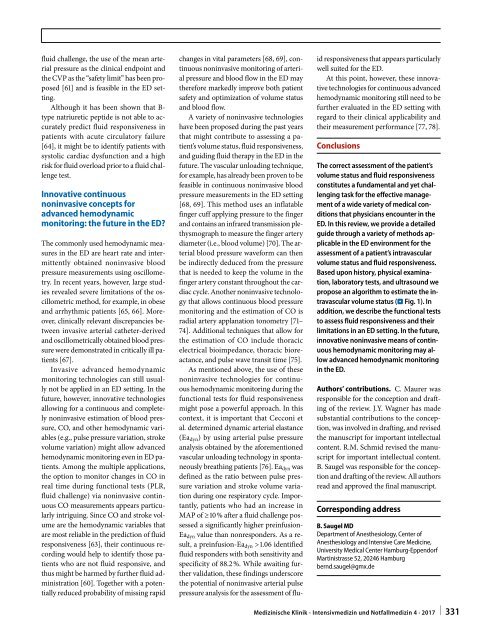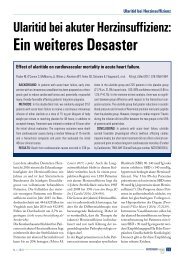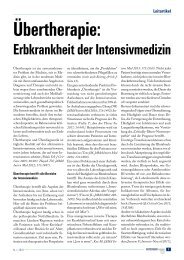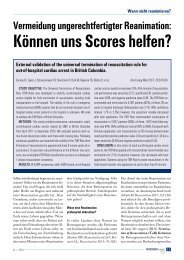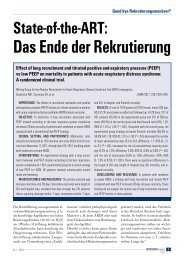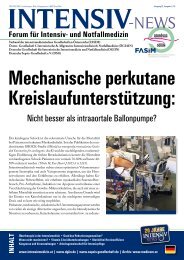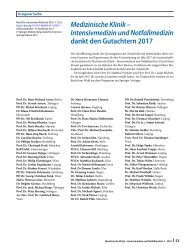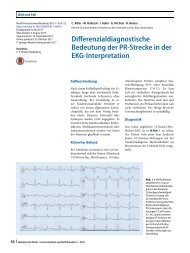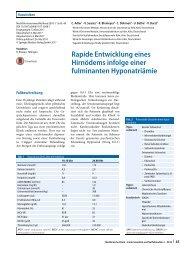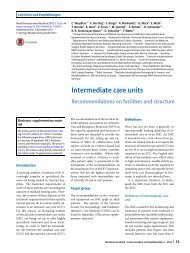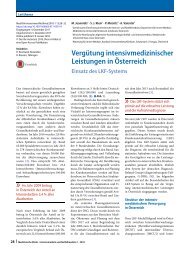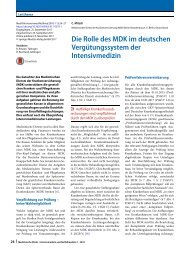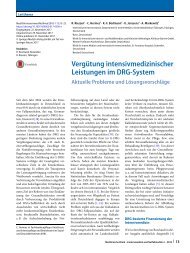08 Assessment of volume status and fluid responsiveness in the emergency department
Create successful ePaper yourself
Turn your PDF publications into a flip-book with our unique Google optimized e-Paper software.
<strong>fluid</strong> challenge, <strong>the</strong> use <strong>of</strong> <strong>the</strong> mean arterial<br />
pressure as <strong>the</strong> cl<strong>in</strong>ical endpo<strong>in</strong>t <strong>and</strong><br />
<strong>the</strong> CVP as <strong>the</strong> “safety limit” has been proposed<br />
[61] <strong>and</strong> is feasible <strong>in</strong> <strong>the</strong> ED sett<strong>in</strong>g.<br />
Although it has been shown that B-<br />
type natriuretic peptide is not able to accurately<br />
predict <strong>fluid</strong> <strong>responsiveness</strong> <strong>in</strong><br />
patients with acute circulatory failure<br />
[64], it might be to identify patients with<br />
systolic cardiac dysfunction <strong>and</strong> a high<br />
risk for <strong>fluid</strong> overload prior to a <strong>fluid</strong> challenge<br />
test.<br />
Innovative cont<strong>in</strong>uous<br />
non<strong>in</strong>vasive concepts for<br />
advanced hemodynamic<br />
monitor<strong>in</strong>g: <strong>the</strong> future <strong>in</strong> <strong>the</strong> ED?<br />
The commonly used hemodynamic measures<br />
<strong>in</strong> <strong>the</strong> ED are heart rate <strong>and</strong> <strong>in</strong>termittently<br />
obta<strong>in</strong>ed non<strong>in</strong>vasive blood<br />
pressure measurements us<strong>in</strong>g oscillometry.<br />
In recent years, however, large studies<br />
revealed severe limitations <strong>of</strong> <strong>the</strong> oscillometric<br />
method, for example, <strong>in</strong> obese<br />
<strong>and</strong> arrhythmic patients [65, 66]. Moreover,<br />
cl<strong>in</strong>ically relevant discrepancies between<br />
<strong>in</strong>vasive arterial ca<strong>the</strong>ter-derived<br />
<strong>and</strong> oscillometrically obta<strong>in</strong>ed blood pressure<br />
were demonstrated <strong>in</strong> critically ill patients<br />
[67].<br />
Invasive advanced hemodynamic<br />
monitor<strong>in</strong>g technologies can still usually<br />
not be applied <strong>in</strong> an ED sett<strong>in</strong>g. In <strong>the</strong><br />
future, however, <strong>in</strong>novative technologies<br />
allow<strong>in</strong>g for a cont<strong>in</strong>uous <strong>and</strong> completely<br />
non<strong>in</strong>vasive estimation <strong>of</strong> blood pressure,<br />
CO, <strong>and</strong> o<strong>the</strong>r hemodynamic variables<br />
(e.g., pulse pressure variation, stroke<br />
<strong>volume</strong> variation) might allow advanced<br />
hemodynamic monitor<strong>in</strong>g even <strong>in</strong> ED patients.<br />
Among <strong>the</strong> multiple applications,<br />
<strong>the</strong> option to monitor changes <strong>in</strong> CO <strong>in</strong><br />
real time dur<strong>in</strong>g functional tests (PLR,<br />
<strong>fluid</strong> challenge) via non<strong>in</strong>vasive cont<strong>in</strong>uous<br />
CO measurements appears particularly<br />
<strong>in</strong>trigu<strong>in</strong>g. S<strong>in</strong>ce CO <strong>and</strong> stroke <strong>volume</strong><br />
are <strong>the</strong> hemodynamic variables that<br />
are most reliable <strong>in</strong> <strong>the</strong> prediction <strong>of</strong> <strong>fluid</strong><br />
<strong>responsiveness</strong> [63], <strong>the</strong>ir cont<strong>in</strong>uous record<strong>in</strong>g<br />
would help to identify those patients<br />
who are not <strong>fluid</strong> responsive, <strong>and</strong><br />
thus might be harmed by fur<strong>the</strong>r <strong>fluid</strong> adm<strong>in</strong>istration<br />
[60]. Toge<strong>the</strong>r with a potentially<br />
reduced probability <strong>of</strong> miss<strong>in</strong>g rapid<br />
changes <strong>in</strong> vital parameters [68, 69], cont<strong>in</strong>uous<br />
non<strong>in</strong>vasive monitor<strong>in</strong>g <strong>of</strong> arterial<br />
pressure <strong>and</strong> blood flow <strong>in</strong> <strong>the</strong> ED may<br />
<strong>the</strong>refore markedly improve both patient<br />
safety <strong>and</strong> optimization <strong>of</strong> <strong>volume</strong> <strong>status</strong><br />
<strong>and</strong> blood flow.<br />
A variety <strong>of</strong> non<strong>in</strong>vasive technologies<br />
have been proposed dur<strong>in</strong>g <strong>the</strong> past years<br />
that might contribute to assess<strong>in</strong>g a patient’s<br />
<strong>volume</strong> <strong>status</strong>, <strong>fluid</strong> <strong>responsiveness</strong>,<br />
<strong>and</strong> guid<strong>in</strong>g <strong>fluid</strong> <strong>the</strong>rapy <strong>in</strong> <strong>the</strong> ED <strong>in</strong> <strong>the</strong><br />
future. The vascular unload<strong>in</strong>g technique,<br />
for example, has already been proven to be<br />
feasible <strong>in</strong> cont<strong>in</strong>uous non<strong>in</strong>vasive blood<br />
pressure measurements <strong>in</strong> <strong>the</strong> ED sett<strong>in</strong>g<br />
[68, 69]. This method uses an <strong>in</strong>flatable<br />
f<strong>in</strong>ger cuff apply<strong>in</strong>g pressure to <strong>the</strong> f<strong>in</strong>ger<br />
<strong>and</strong> conta<strong>in</strong>s an <strong>in</strong>frared transmission plethysmograph<br />
to measure <strong>the</strong> f<strong>in</strong>ger artery<br />
diameter (i.e., blood <strong>volume</strong>) [70]. The arterial<br />
blood pressure waveform can <strong>the</strong>n<br />
be <strong>in</strong>directly deduced from <strong>the</strong> pressure<br />
that is needed to keep <strong>the</strong> <strong>volume</strong> <strong>in</strong> <strong>the</strong><br />
f<strong>in</strong>ger artery constant throughout <strong>the</strong> cardiac<br />
cycle. Ano<strong>the</strong>r non<strong>in</strong>vasive technology<br />
that allows cont<strong>in</strong>uous blood pressure<br />
monitor<strong>in</strong>g <strong>and</strong> <strong>the</strong> estimation <strong>of</strong> CO is<br />
radial artery applanation tonometry [71–<br />
74]. Additional techniques that allow for<br />
<strong>the</strong> estimation <strong>of</strong> CO <strong>in</strong>clude thoracic<br />
electrical bioimpedance, thoracic bioreactance,<br />
<strong>and</strong> pulse wave transit time [75].<br />
As mentioned above, <strong>the</strong> use <strong>of</strong> <strong>the</strong>se<br />
non<strong>in</strong>vasive technologies for cont<strong>in</strong>uous<br />
hemodynamic monitor<strong>in</strong>g dur<strong>in</strong>g <strong>the</strong><br />
functional tests for <strong>fluid</strong> <strong>responsiveness</strong><br />
might pose a powerful approach. In this<br />
context, it is important that Cecconi et<br />
al. determ<strong>in</strong>ed dynamic arterial elastance<br />
(Ea dyn ) by us<strong>in</strong>g arterial pulse pressure<br />
analysis obta<strong>in</strong>ed by <strong>the</strong> aforementioned<br />
vascular unload<strong>in</strong>g technology <strong>in</strong> spontaneously<br />
breath<strong>in</strong>g patients [76]. Ea dyn was<br />
def<strong>in</strong>ed as <strong>the</strong> ratio between pulse pressure<br />
variation <strong>and</strong> stroke <strong>volume</strong> variation<br />
dur<strong>in</strong>g one respiratory cycle. Importantly,<br />
patients who had an <strong>in</strong>crease <strong>in</strong><br />
MAP <strong>of</strong> ≥ 10 % after a <strong>fluid</strong> challenge possessed<br />
a significantly higher pre<strong>in</strong>fusion-<br />
Ea dyn value than nonresponders. As a result,<br />
a pre<strong>in</strong>fusion-Ea dyn > 1.06 identified<br />
<strong>fluid</strong> responders with both sensitivity <strong>and</strong><br />
specificity <strong>of</strong> 88.2 %. While await<strong>in</strong>g fur<strong>the</strong>r<br />
validation, <strong>the</strong>se f<strong>in</strong>d<strong>in</strong>gs underscore<br />
<strong>the</strong> potential <strong>of</strong> non<strong>in</strong>vasive arterial pulse<br />
pressure analysis for <strong>the</strong> assessment <strong>of</strong> <strong>fluid</strong><br />
<strong>responsiveness</strong> that appears particularly<br />
well suited for <strong>the</strong> ED.<br />
At this po<strong>in</strong>t, however, <strong>the</strong>se <strong>in</strong>novative<br />
technologies for cont<strong>in</strong>uous advanced<br />
hemodynamic monitor<strong>in</strong>g still need to be<br />
fur<strong>the</strong>r evaluated <strong>in</strong> <strong>the</strong> ED sett<strong>in</strong>g with<br />
regard to <strong>the</strong>ir cl<strong>in</strong>ical applicability <strong>and</strong><br />
<strong>the</strong>ir measurement performance [77, 78].<br />
Conclusions<br />
The correct assessment <strong>of</strong> <strong>the</strong> patient’s<br />
<strong>volume</strong> <strong>status</strong> <strong>and</strong> <strong>fluid</strong> <strong>responsiveness</strong><br />
constitutes a fundamental <strong>and</strong> yet challeng<strong>in</strong>g<br />
task for <strong>the</strong> effective management<br />
<strong>of</strong> a wide variety <strong>of</strong> medical conditions<br />
that physicians encounter <strong>in</strong> <strong>the</strong><br />
ED. In this review, we provide a detailed<br />
guide through a variety <strong>of</strong> methods applicable<br />
<strong>in</strong> <strong>the</strong> ED environment for <strong>the</strong><br />
assessment <strong>of</strong> a patient’s <strong>in</strong>travascular<br />
<strong>volume</strong> <strong>status</strong> <strong>and</strong> <strong>fluid</strong> <strong>responsiveness</strong>.<br />
Based upon history, physical exam<strong>in</strong>ation,<br />
laboratory tests, <strong>and</strong> ultrasound we<br />
propose an algorithm to estimate <strong>the</strong> <strong>in</strong>travascular<br />
<strong>volume</strong> <strong>status</strong> (. Fig. 1). In<br />
addition, we describe <strong>the</strong> functional tests<br />
to assess <strong>fluid</strong> <strong>responsiveness</strong> <strong>and</strong> <strong>the</strong>ir<br />
limitations <strong>in</strong> an ED sett<strong>in</strong>g. In <strong>the</strong> future,<br />
<strong>in</strong>novative non<strong>in</strong>vasive means <strong>of</strong> cont<strong>in</strong>uous<br />
hemodynamic monitor<strong>in</strong>g may allow<br />
advanced hemodynamic monitor<strong>in</strong>g<br />
<strong>in</strong> <strong>the</strong> ED.<br />
Authors’ contributions. C. Maurer was<br />
responsible for <strong>the</strong> conception <strong>and</strong> draft<strong>in</strong>g<br />
<strong>of</strong> <strong>the</strong> review. J.Y. Wagner has made<br />
substantial contributions to <strong>the</strong> conception,<br />
was <strong>in</strong>volved <strong>in</strong> draft<strong>in</strong>g, <strong>and</strong> revised<br />
<strong>the</strong> manuscript for important <strong>in</strong>tellectual<br />
content. R.M. Schmid revised <strong>the</strong> manuscript<br />
for important <strong>in</strong>tellectual content.<br />
B. Saugel was responsible for <strong>the</strong> conception<br />
<strong>and</strong> draft<strong>in</strong>g <strong>of</strong> <strong>the</strong> review. All authors<br />
read <strong>and</strong> approved <strong>the</strong> f<strong>in</strong>al manuscript.<br />
Correspond<strong>in</strong>g address<br />
B. Saugel MD<br />
Department <strong>of</strong> Anes<strong>the</strong>siology, Center <strong>of</strong><br />
Anes<strong>the</strong>siology <strong>and</strong> Intensive Care Medic<strong>in</strong>e,<br />
University Medical Center Hamburg-Eppendorf<br />
Mart<strong>in</strong>istrasse 52, 20246 Hamburg<br />
bernd.saugel@gmx.de<br />
Mediz<strong>in</strong>ische Kl<strong>in</strong>ik - Intensivmediz<strong>in</strong> und Notfallmediz<strong>in</strong> 4 · 2017 |<br />
331


